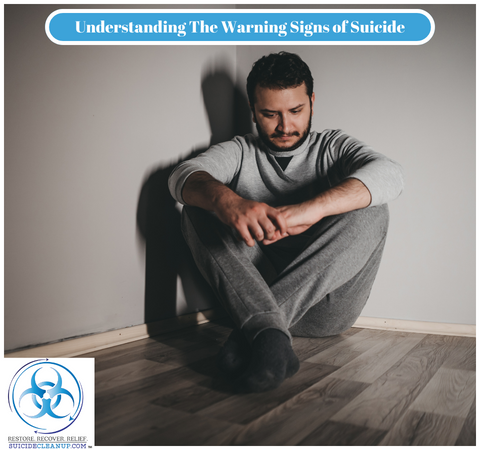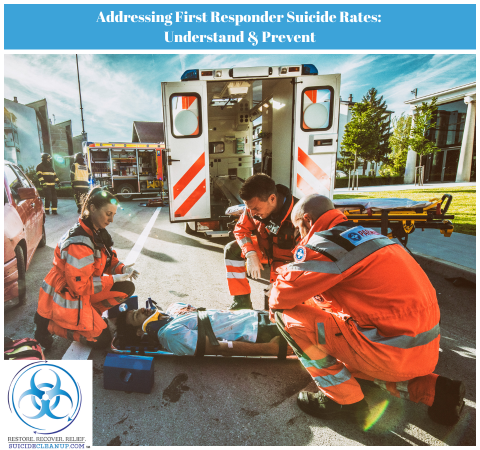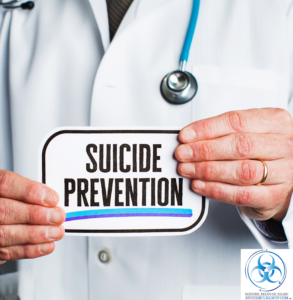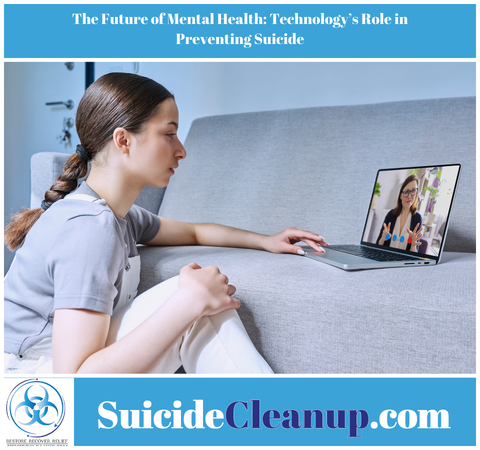
Understanding The Warning Signs of Suicide
February 14, 2024
Addressing First Responder Suicide Rates: Understand & Prevent
April 30, 2024In the 21st century, the intersection of technology and mental health has become increasingly prominent, offering innovative solutions to longstanding challenges. This is particularly evident in the realm of suicide prevention, where digital tools and advancements are playing a crucial role in supporting the needs of an individual. Mental health technology encompasses a wide range of digital tools and platforms designed to enhance mental well-being and provide support to those experiencing mental health issues. These technologies include mobile applications, online therapy platforms, wearable devices, and digital monitoring systems, among others.
Suicide prevention tools such as crisis hotlines, chatbots, and online support groups are helping individuals in crisis connect with trained professionals and access immediate support. These tools provide a lifeline to those who may be struggling and offer a safe space to talk about their feelings. Tech innovations in mental health are also revolutionizing the field by providing more personalized and accessible care. For example, virtual reality therapy is being used to treat conditions such as post-traumatic stress disorder (PTSD) and phobias, offering a new way to approach mental health treatment.
Digital mental health solutions, including teletherapy and telepsychiatry, are also becoming increasingly popular, allowing individuals to access mental health services from the comfort of their own homes. These solutions are particularly beneficial for those who may face barriers to traditional in-person care, such as long wait times or limited access to mental health professionals. Overall, technology is playing a pivotal role in shaping the future of mental health and suicide prevention. As these innovations continue to evolve, they have the potential to revolutionize the way we approach mental health care and support individuals in need.
The Current Landscape of Suicide Prevention and the Need for Technological Interventions
 The current landscape of suicide prevention is characterized by a pressing need for effective interventions to address the growing societal impact of suicide. According to the World Health Organization (WHO), over 700,000 people die due to suicide every year, making it a major public health concern worldwide. Suicide rates have been steadily increasing over the past few decades, highlighting the urgency of implementing comprehensive prevention strategies.
The current landscape of suicide prevention is characterized by a pressing need for effective interventions to address the growing societal impact of suicide. According to the World Health Organization (WHO), over 700,000 people die due to suicide every year, making it a major public health concern worldwide. Suicide rates have been steadily increasing over the past few decades, highlighting the urgency of implementing comprehensive prevention strategies.
Traditional suicide prevention strategies often focus on raising awareness, reducing stigma, and providing mental health education. While these efforts are crucial, they are often not enough to address the complex nature of suicide. Many individuals at risk of suicide may not seek help due to various barriers, including stigma, lack of access to mental health services, and fear of judgment.
Mental health crisis intervention plays a critical role in suicide prevention, as it provides immediate support to individuals in acute distress. Crisis hotlines, crisis centers, and mobile crisis teams are among the key resources available to those in need of urgent assistance. These interventions can help de-escalate crises, provide emotional support, and connect individuals to appropriate mental health services.
Despite these efforts, suicide rates continue to rise, underscoring the need for innovative technological interventions. Technology has the potential to bridge gaps in traditional mental health care by providing accessible, cost-effective, and scalable solutions. For example, artificial intelligence (AI) and machine learning algorithms can help identify individuals at risk of suicide based on their online behavior and communication patterns, enabling early intervention.
Moreover, digital platforms and mobile applications can provide real-time support and resources to individuals in crisis, offering a lifeline to those who may not have access to traditional mental health services. These technological interventions have the potential to revolutionize suicide prevention by providing timely and personalized support to individuals in need, ultimately saving lives.
AI and Machine Learning: Predictive Analytics for Early Suicide Risk Detection
Harnessing artificial intelligence (AI) and machine learning (ML) for predictive analytics is a groundbreaking approach in early suicide risk detection and prevention. AI-powered tools have the ability to analyze vast amounts of data, including social media posts, text messages, and online activity, to identify patterns and indicators of suicide risk. According to a research paper available on the National Center for Biotechnology Information’s website, AI appears to have a high potential for identifying patients at risk of suicide. This paper examines 17 studies on the topic published between 2014 and 2020 which attempt to either predict an individual suicide risk or identify at risk individuals within a population. The paper concludes that “This technology may allow a significant evolution in suicide risk assessment, with a more accurate and reliable assessment than with present methods. This tool is likely to become more accessible in the coming years.”
Machine learning algorithms can be trained to recognize language patterns and behaviors associated with suicidal ideation, allowing for early intervention. These algorithms can flag individuals who may be at risk based on their online interactions, enabling mental health professionals to reach out and offer support before a crisis occurs. 2 potential applications of AL and ML in suicide prevention:
- Natural Language Processing (NLP) to analyze text data- NLP algorithms can identify linguistic cues and expressions that may indicate suicidal thoughts or intentions, even in cases where individuals may not explicitly express their distress.
- Predictive analytics for suicide risk assessment- By analyzing various data points, such as demographic information, medical history, and behavioral patterns, predictive models can estimate an individual’s likelihood of attempting suicide. These models can help prioritize intervention efforts and allocate resources more effectively.
Overall, AI and machine learning hold immense potential in revolutionizing suicide prevention by enabling early detection and intervention. By leveraging these technologies, we can move towards a future where suicide risk is identified and addressed proactively, ultimately saving lives.
Telehealth and Virtual Support: Bridging Gaps in Access to Mental Health Services
Telehealth and virtual support systems are increasingly becoming vital components in bridging gaps in access to mental health services, particularly for at-risk individuals. Telehealth, virtual therapy platforms and online counseling, offer a convenient and accessible alternative to traditional in-person therapy. These platforms allow individuals to connect with mental health professionals remotely, eliminating barriers such as transportation, scheduling conflicts, and geographical limitations. For at-risk individuals who may be hesitant to seek help or unable to access traditional services, telehealth offers a lifeline by providing confidential and convenient support.
Virtual therapy platforms and online counseling sessions provide a range of mental health services, including individual therapy, group therapy, and crisis intervention. These platforms often incorporate secure video conferencing, messaging, and other interactive features to simulate the experience of an in-person session. For at-risk individuals, the availability of immediate support through telehealth can be life-saving. In times of crisis, individuals can access virtual counseling services from the comfort and privacy of their own homes, reducing the risk of self-harm or suicide attempts. Moreover, telehealth allows mental health professionals to reach underserved populations, including rural communities and individuals with limited mobility. By breaking down barriers to access, telehealth is revolutionizing mental health care and improving outcomes for at-risk individuals.
Ethical Considerations and Data Privacy
While technology-driven suicide prevention measures offer significant benefits, such as early risk detection and increased access to mental health services, they also present challenges related to confidentiality, consent, and data security. It is crucial to address ethical considerations and data privacy concerns to ensure that these technologies are used responsibly.
- One of the key ethical implications of mental health tech is the potential for unintended consequences, such as false positives or misinterpretation of data. Machine learning algorithms, while powerful, are not foolproof and can sometimes produce inaccurate or biased results. This raises concerns about the potential for individuals to be wrongly flagged as at risk, leading to unnecessary interventions or stigma.
- Data security is another critical issue in suicide prevention apps and digital interventions. These platforms collect sensitive information about individuals’ mental health status, behaviors, and interactions, raising concerns about data breaches and unauthorized access. Ensuring robust data security measures, such as encryption and secure storage, is essential to protect the privacy of users.
- Privacy concerns also extend to the use of personal data for research and commercial purposes. Mental health tech companies must be transparent about how they collect, use, and share data, and obtain informed consent from users. Additionally, they should adhere to strict privacy policies and regulations, such as the Health Insurance Portability and Accountability Act (HIPAA), to protect users’ privacy and confidentiality.
Embracing Tech-Enabled Solutions to Revolutionize Suicide Prevention
By harnessing the power of AI, machine learning, telehealth, and virtual support systems, we can reach at-risk individuals more effectively, provide timely interventions, and ultimately save lives. However, it is crucial to address ethical considerations and data privacy concerns to ensure that these technologies are implemented responsibly. With continued innovation and collaboration between technology developers, mental health professionals, and policymakers, we can create a future where suicide prevention is more effective, accessible, and compassionate for individuals around the world.
At SuicideCleanup.com we see the tragedy of suicide first hand and witness the impact it can have on loved ones. That is why we make it a point to stay on top of the latest in mental health a suicide prevention. If you or a loved one are in dire need of help please visit our resources page to find a mental health specialist near you.




